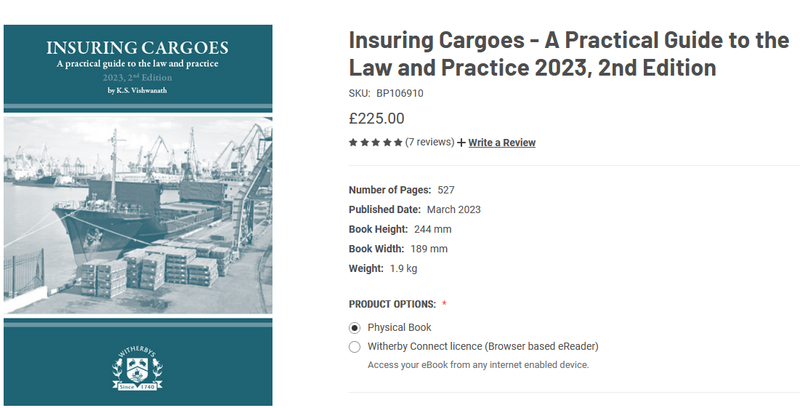The 2nd edition of "Insuring Cargoes - A practical guide to the law and practice" authored by K.S. Vishwanath was recently published by Witherbys of UK.
The 2nd edition bears little resemblance to the first edition and seems to have been virtually rewritten.
The book contains a wide array of topics, a tour de force on marine cargo insurance, reflecting the author’s depth and insight into the subject.
There is a fine balance between law and practice. Concepts are well illustrated with examples drawn no doubt from the author’s long experience as a practitioner. The author has a penchant for scenario-building to examine outcome of policy wordings. The book cites all relevant case laws from English and American courts but in essence it offers a practical insight into marine cargo insurance.
The first chapter deals with not only the basic concepts of marine cargo insurance which are analysed with the help of examples drawn from the author’s experience and case laws but also examines in detail various aspects of international trade including a critical look at Incoterms 2020 and the Insurance Act 2015 of UK. The first chapter also provides examples of various methods of double insurance which one does not find in other books.
Chapters 2 and 3 provide a discussion on English law as it stands on insurable interest. For instance, economic insurable interest is yet to be recognised in English law and the fallout from this is discussed in the context of sale contracts where risk and title is passed on to the buyer but the seller remains unpaid. The position of unpaid Seller including the unpaid CIF /CIP seller is discussed in detail and boldly questions the current practice of extending Sellers Contingency covers only to FOB/CFR and similar contracts.
The fourth chapter deals with various components of a marine open cover such as nature of bottom and location limits as well as the tension between the certificate and the open cover with the former containing just a few of the terms contained in the widely drawn open cover. Sales turnover policies are also discussed at length.
The fifth chapter is devoted to the Institute Classification Clause, ISM and ISPS endorsements.
Chapter 6 on 2009 edition of Institute Clauses (A) is exhaustive and contains an in-depth analysis of perils, exclusions and duration of cover. The author provides possible claims scenarios and examines how the 2009 clauses would respond. The chapter also highlights the possibility of insurers not extending the cover in certain circumstances and hence the need for brokers to have a suitable Continuation clause to keep the policy alive till goods reach the insured destination.
The 7th chapter deals with inherent vice and delay exclusions and possible buy-back covers.
The next three chapters that follow deal with ‘named’ perils and trade clauses such as ICC(B) and (C), Bulk Oil Clauses including Guaranteed Outturn, Institute Theft Pilferage and/or Non Delivery and the latest clauses for frozen foods/meat. Again the outcome of claims based on these clauses are discussed in the light of possible claim scenarios.
One of the highlights of the 2nd edition is a chapter devoted to an in-depth analysis of several broker wordings (non-Institute clauses).
There are new chapters on War and SRCC, Contract Certainty and Rejection Covers. The chapter on Contract Certainty deals with ambiguous wordings and goes on to discuss how bespoke wordings are developed with examples from the mining and pharmaceutical industries. Unintended consequences of some popular exclusion-wordings are discussed reflecting the author’s emphasis on contract certainty in policies.
Two chapters have been devoted to claims and very well written. There is an in-depth discussion on physical loss or damage type of cover and its relevance to pharmaceutical products. Miscellaneous topics include successive losses, piracy and exchange rate fluctuations and how they are to be dealt with.
The last chapter is on recoveries contributed by Jai Sharma of Clyde and Co, London. The author explains in his Preface that the “focus of this chapter is the pitfalls that can trap the unwary on a recovery claim rather than everything the reader needs to know about recoveries.”
The book is interspersed with ideas and concepts which are thought provoking.
As an annex to the book, there is a very exhaustive list of claim documentation for general cargo, dry and liquid bulk.
The 2nd edition is a heavy book of 560 pages-perhaps reason why an Index has not been included. The book is well divided into chapters and sections along with a Contents List giving section-wise topics covered which will hopefully make it easy to navigate without an index.
Mr. Mike Roderick of Clyde & Co, London who has written the Foreword says about the book:
“The author does not shirk from tackling problematic areas……The author writes on these issues in a stimulating and authoritative manner. …. It is commended to any reader interested in marine cargo insurance”.
The book is priced at GBP 225. Like all technical book, this book too is expensive but is most certainly a welcome addition to the library of any serious practitioner of marine cargo insurance who is interested in contract certainty in policies and wants a thorough grip over the legal and practical aspects of cargo insurance.
More information about the book is available at Witherbys:

